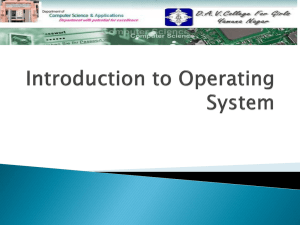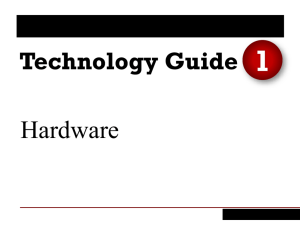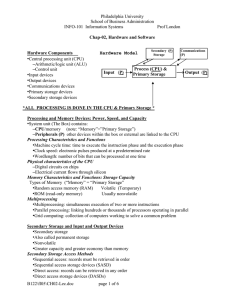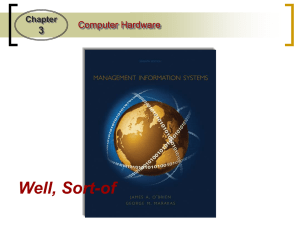Management Information Systems
advertisement
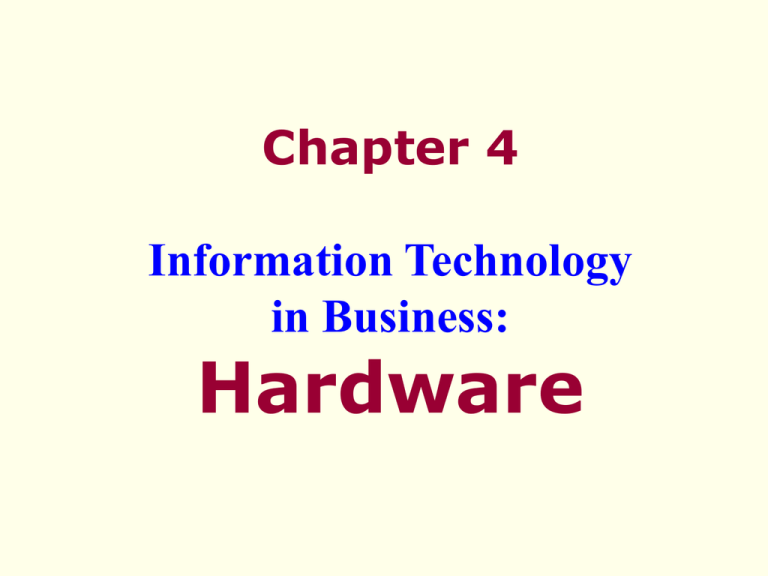
Chapter 4 Information Technology in Business: Hardware The Central Tool of Modern Information Systems Four Basic Functions of Computers Accept data Process data Store data and instructions Output data 2 All computers have the same basic components. 3 The Central Tool of Modern Information Systems Organizations have moved from using large mainframes to using networked PCs. 4 Computers Communicating: Bits And Bytes Computer recognizes two states: on or off Each on or off signal represents a bit (binary digit) 5 A Peek Inside the Computer Figure 4.6 A look inside a computer 6 A Peek Inside the Computer The Central Processing Unit (CPU) The brain of the computer Microprocessor Carries Two signals that execute all processing Components: Control unit Arithmetic logic unit (ALU) 7 Microprocessor Microprocessor Silicon chip embedded with transistors, or semiconductors letter D : 11000100 Schematic of how circuits on a chip would be open and closed to represent the letter D in EBCDIC (11000100) 8 –CPU’s execution of four functions: 1.Fetch 2. Decode 3.Execute 4. Store What happens inside the CPU in one machine cycle executing the operation 7 + 5 9 Machine Cycle Machine Cycle CPU’s execution of four functions: Fetch Decode Execute Store Functions measured in small fractions of a second 10 TYPES OF MEMORY Memory Internal Memory Random access memory (RAM) Read-only memory (ROM) External Memory Magnetic disks, magnetic tapes, optical discs 11 Computer Power Computer Power Clock rate (measured in cycles per second) Amount of information the CPU can process per second 1Mhz= 1 million Machine Cycle Speed determined only by combination of both factors 12 Input Devices Keyboard Mouse, Trackball, and Track Pad Touch Screen Source Data Input Devices Imaging Speech Recognition 13 Output Devices Soft-Copy Output Devices Cathode-Ray Tube (CRT) Monitor Flat-Panel Monitor Speech Output Hardcopy Output Devices Nonimpact Printers (most common) Impact Printers 14 External Storage Media Important Properties to Consider Capacity Speed Cost 15 External Storage Media Magnetic Tapes Magnetic Disks Optical Discs (Compact Discs) Optical Tapes 16 External Storage Media 17 Classification of Computers Supercomputers The largest, most powerful, and most expensive Used by universities, research institutions, and large corporations Mainframe Computers Less powerful and less expensive than supercomputers Used by businesses with large amounts of data that need to be stored in a central computer 18 Classification of Computers Minicomputers Often used as the host computer in a network of smaller computers Priced in the tens of thousands to a few hundred thousand dollars Manufacturers: DEC (VAX), IBM (AS/400), and Hewlett-Packard 19 Compatibility Software and peripheral devices from one computer can be used with another computer. In a networked environment, computers need to communicate to share databases and other computing resources. In addition to power and cost, compatibility is an extremely important factor in purchasing decisions. 20 Considerations in Purchasing Hardware What should you consider when buying hardware? Power -- speed, size of memory, storage capacity Expansion and upgrade capability Ports for external devices like printers, hard disks, communication devices Ergonomics: Keyboard, Monitor Vendor reliability, warranty policy, vendor support 21 Considerations in Purchasing Hardware Factor What to Look For •Power Greater frequency and word size, larger •Expandability Greater number of board slots for additional RAM •Ports Greater number of ports for printer, external hard disk, communication devices and other peripherals •Ergonomics Greater comfort and safety •Compatibility Comparability with many other computers and peripheral devices, as swell as software packages •Footprint Smaller area •Support Availability of telephone and on-line support for troubleshooting •Warranty Longer warranty period •Cost Lower cost 22 SEQUENTIAL & PARALLEL PROCESSING SEQUENTIAL PARALLEL Program Program TASK 1 CPU RESULT Program CPU CPU CPU TASK 1 TASK 2 TASK 3 RESULT TASK 2 CPU RESULT 23 CLIENT / SERVER CLIENT REQUESTS SERVER DATA, SERVICE USER INTERFACE DATA APPLICATION APPLICATION FUNCTION FUNCTION NETWORK RESOURCES 24



